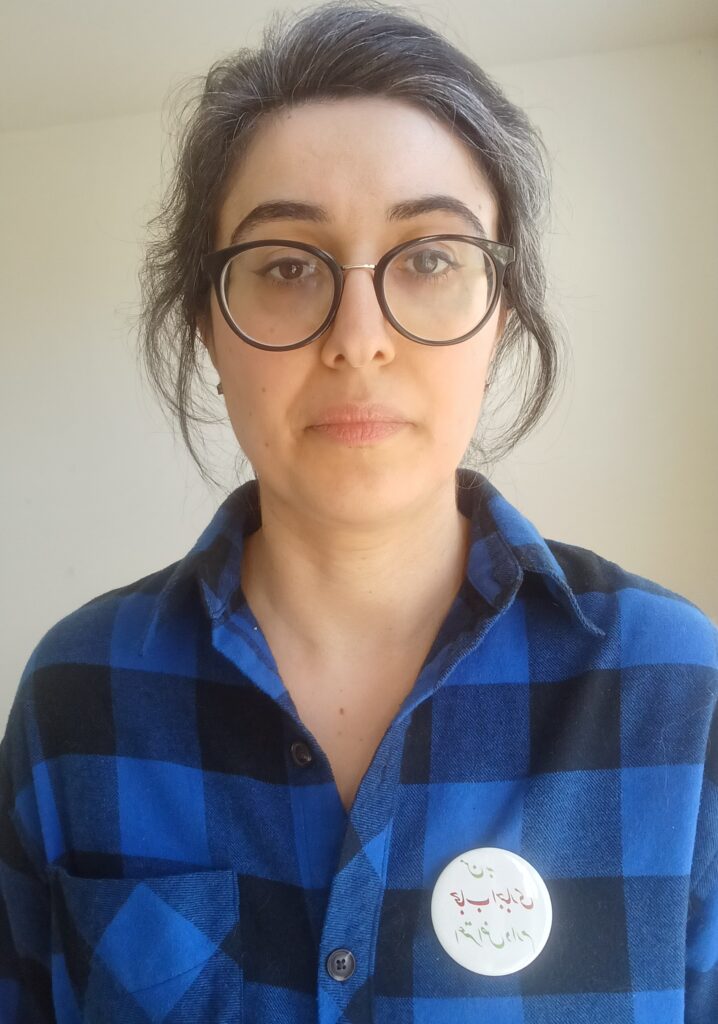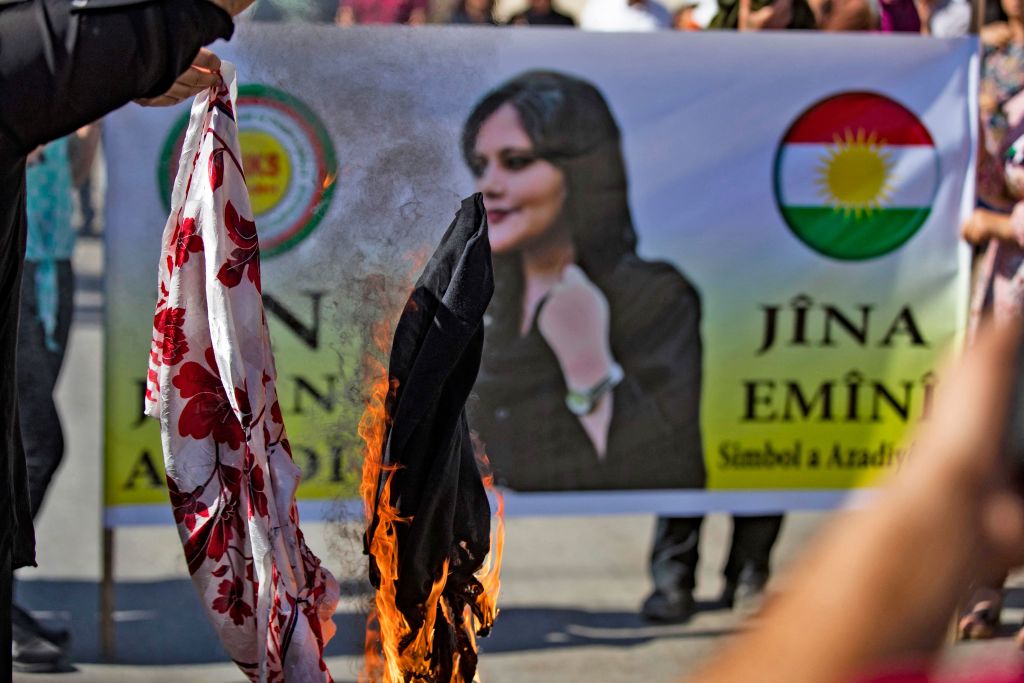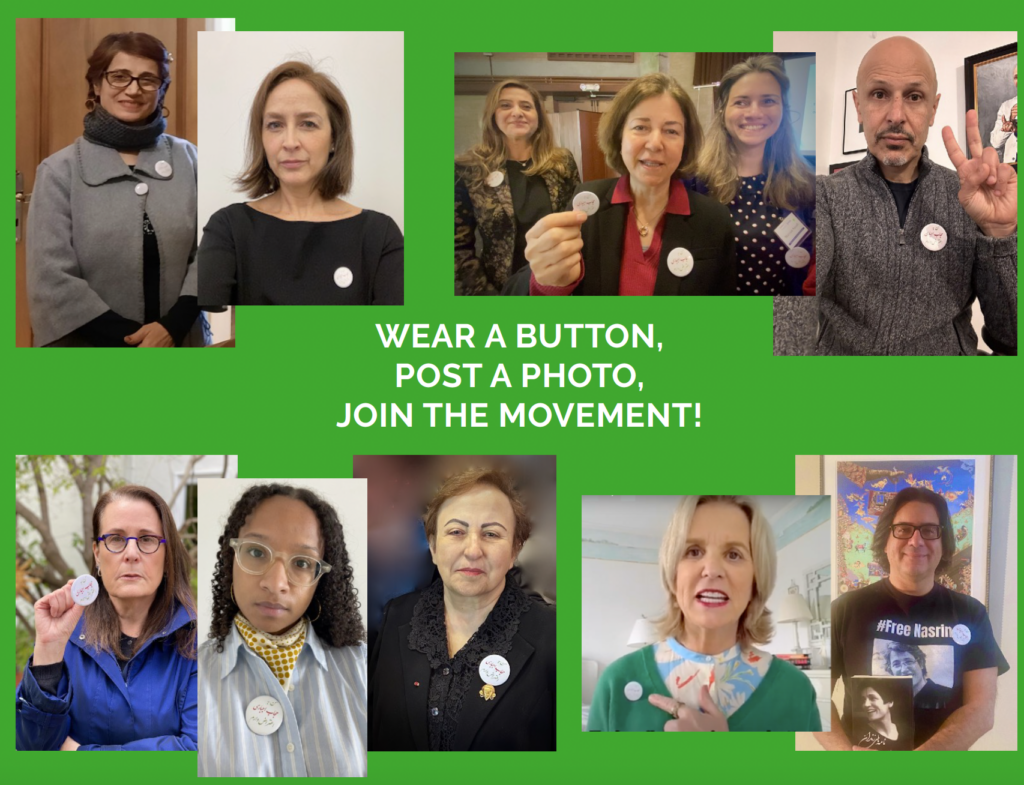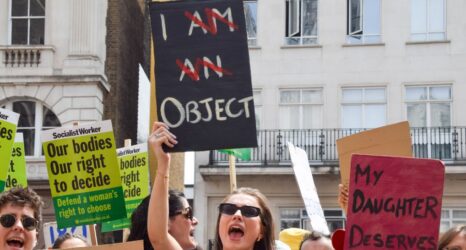Buttons that say “I oppose the mandatory hijab” in Persian are cropping up around the world and on social media—showing that the fight for women’s rights in Iran is a global one.
To request your own I OPPOSE THE MANDATORY HIJAB #FreedomButton, head here.
Last week, I received in the mail three buttons with the Iranian flag’s white, green and red colors. The package came from Jeff Kaufman and Marcia Ross, the director and producer (respectively) of the documentary Nasrin (2021) and the force behind a global solidarity campaign supporting the Woman, Life, Freedom movement in Iran.
Dubbed the #FreedomButton, they read, “I oppose the mandatory hijab” in Persian.

For me, the word hijab evokes a flood of thoughts and emotions. Wearing it never bothered me when I was growing up in Isfahan, a small, conservative town in central Iran. It was the 1990s, and most things, including following strict laws, were matters of survival. The lines were clear: To live in Iran is to live a double life, where the public and the private are kept apart. At home, my parents never cared how much of my hair peeped under my headscarf.
It wasn’t until I came to America when I was 18 that, for the first time, the debate around hijab grabbed my attention. I met first-generation Iranians who were forced by their religious parents to wear the hijab. I also met children of Muslim immigrants who wanted to wear the hijab, but were forbidden by their parents who, in the rise of post-9/11 Islamophobia, were concerned for their safety. I realized wearing the hijab had never bothered me because I had the sanctuary of my home and progressive parents. Most importantly, I was privileged to have the luxury of immigrating to America. I had a choice.
The “I oppose the mandatory hijab” buttons represent Iranian women today who don’t have choices.

Women’s decisions about their own clothing and appearance—particularly the hijab—has been policed throughout modern Iranian history.
In 1936, Reza Shah—the first monarch of the Pahlavi dynasty who was infatuated with the Western definition of modernity—ordered women to bare their heads and bodies of headscarves or chadors (which leave only the face or eyes exposed). Religious women who didn’t wish to follow suit were met with violence and criminal punishment.
Fast forward to the 1979 revolution, when women were ordered to cover their heads and bodies with headscarves or chadors. This time, secular women who didn’t wish to follow suit were met with violence and criminal punishment.
Since then, many women in Iran have been humiliated, beaten, arrested, sexually harassed in custody, forced to repent publicly or pay fines, imprisoned, and, worst of all, killed. The most horrifying example is Mahsa Amini, whose photograph from the hospital when she was bruised and bloodied on life support shook the world in September 2022 and ignited more than six months of protests in the country.
The first Freedom Buttons were made in 2018, when two Iranian men, Reza Khandan, the husband of human rights lawyer and activist Nasrin Sotoudeh (subject of the documentary Nasrin), and their friend Farhad Meysami—also a human rights activist—decided to support the “Girls of Revolution Street,” who publicly waved their headscarves on a stick and received severe punishment for it. In solidarity, Khandan and Meysami hand-pressed thousands of buttons that said, “I oppose the mandatory hijab” in Persian.
The buttons ended up in the hands of the intelligence ministry that had raided the houses and offices of Meysami and Khandan. In the years that followed, Sotoudeh, Khandan and Meysami faced imprisonment and psychological torture, and waged hunger strikes.
Last year, Iran experienced an unprecedented uprising, known as the “Woman, Life, Freedom” movement, which brought men and women of every generation, faith and social and economic class onto the streets. What initially looked like an outcry against the morality police’s unjust and inhumane treatment of women with so-called improper hijab soon proved to be the grievance of a nation fed up with being told what to think, express, write, wear and worship. The movement—called a revolution by some—stood for the idea that if the government can force one yard of cloth on women, they can force the people to do anything.
Now, more than 7,000 miles away, the banished buttons are returning to life. Kaufman and Ross got the idea to reproduce them after seeing Sotoudeh wear her button in a group photo from February with Farhad Meysami after his release from prison. In the picture, Sotoudeh and her husband are standing on two sides of an emaciated, unrecognizable man who has barely survived more than three months of hunger strike.
“I was deeply moved by their life-risking, steadfast support for women’s rights and human rights,” Kaufman said.

He scoffed at the thought of the Iranian government thinking that by confiscating the buttons and the button-making machines, they were crushing their concerns and resolution. “We are showing how absurd that is. The Iranian government has immense repressive power, yet it is terrified by a one-and-a-half-inch piece of metal because it represents an idea that they can’t defeat.”
Today’s #FreedomButton Campaign
Led by Kaufman and Ross, the #FreedomButton campaign is co-signed by organizations and individuals, including: PEN America; Kerry Kennedy, president of Robert F. Kennedy Human Rights; Parliamentarians for Global Action; author Ariel Dorfman; comedian Maz Jobrani; and United Nations special rapporteur on human rights in the Islamic Republic of Iran, Javaid Rehman.
The organizers ask the public to show solidarity for women’s rights in Iran by wearing the button in public and displaying it on social media in a photo or video. To request a button, or for more information, head here.
The wide range of campaign sponsors and supporters show how the fight for women’s rights being waged in Iran is universal.
“The campaign is synonymous with solidarity with women around the world and the fight for the respect of their fundamental human rights, especially in oppressive context,” said Melissa Verpile, director of the gender, equality and inclusion at Parliamentarians for Global Action.

Nasrin Sotoudeh played a large role in making the fight for the hijab one that demands global attention. Sotoudeh’s famous quote: “If the government can dictate what you have on your head, it can dictate what you have in your head,” inspired Elise Auerbach, the Iran country specialist at Amnesty USA, to get involved in the fight.
The #FreedomButton campaign is about standing up to oppressive authoritarians and their brutal crackdowns on women—but it is also about recognizing how the Iranian government pits ordinary citizens against one another. CCTV footage from a grocery store in Iran surfaced last week, in which a man arguing with two young women about their lack of headscarves takes a tub of yogurt out of the refrigerator and throws it at them. It might seem ridiculous or even funny at first, but this is just the beginning. “Sometimes a tub of yogurt; sometimes a bottle of acid,” one response warned.
You don’t have to be Iranian to wear the button. In fact, that’s the point: global solidarity. The freedom to choose hijab—which seems to be the main demand of today’s Iranian protesters—carries within it a long list of demands calling for basic human rights. Here in America, many don’t have ownership of their bodies or are being threatened daily for their sexual orientation.
Anyone who can name one or two of their fundamental rights under threat should wear a button, take a picture and post it on social media.
To request a button, or for more information, head here.
Up next:
U.S. democracy is at a dangerous inflection point—from the demise of abortion rights, to a lack of pay equity and parental leave, to skyrocketing maternal mortality, and attacks on trans health. Left unchecked, these crises will lead to wider gaps in political participation and representation. For 50 years, Ms. has been forging feminist journalism—reporting, rebelling and truth-telling from the front-lines, championing the Equal Rights Amendment, and centering the stories of those most impacted. With all that’s at stake for equality, we are redoubling our commitment for the next 50 years. In turn, we need your help, Support Ms. today with a donation—any amount that is meaningful to you. For as little as $5 each month, you’ll receive the print magazine along with our e-newsletters, action alerts, and invitations to Ms. Studios events and podcasts. We are grateful for your loyalty and ferocity.





